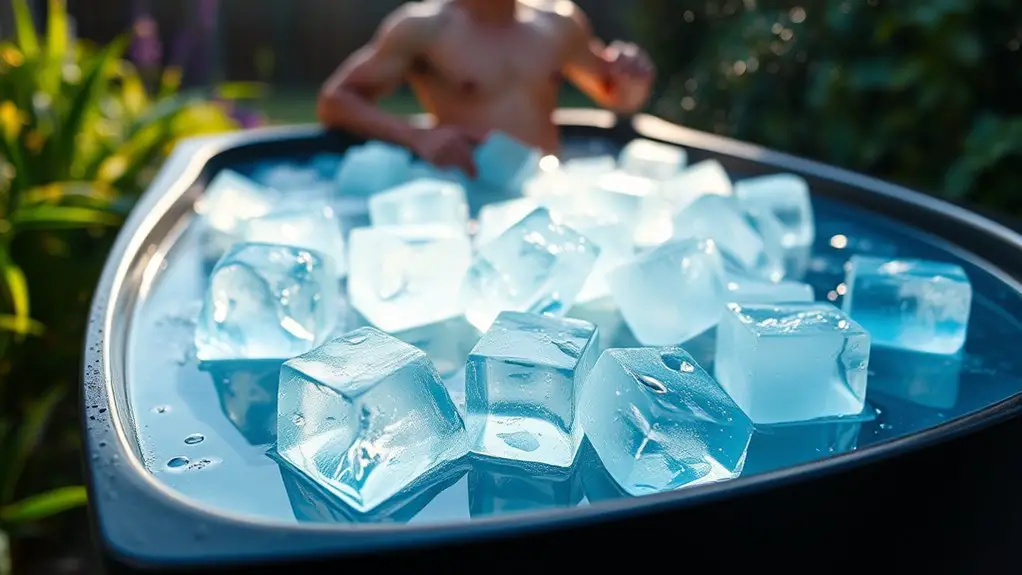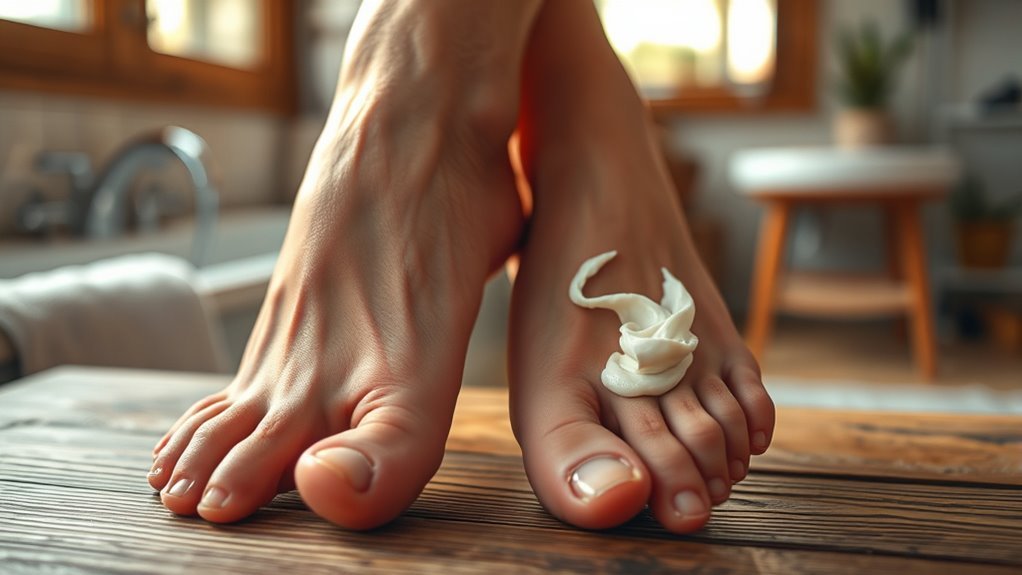Ice baths work by reducing muscle soreness and inflammation after intense workouts. When you immerse in cold water, blood vessels constrict, limiting swelling and pain. Once you warm up, circulation improves, delivering nutrients and oxygen to muscles, aiding recovery. The cooling effect numbs discomfort, allowing you to move more freely. While beneficial, it's crucial to follow best practices and be aware of potential risks. There's so much more to uncover about effective recovery strategies.
Understanding the Physiology of Muscle Recovery
When you push your muscles to their limits during a workout, they undergo tiny tears that can lead to soreness and fatigue. This process is a natural part of muscle growth and strength development. As you challenge your body, these microtears trigger a healing response, where your muscles rebuild stronger than before. This is where freedom comes into play; the more you understand your body's recovery, the more you can optimize your workouts and enjoy the process.
You might notice that adequate rest and nutrition are essential during this recovery phase. Your body craves protein to repair those tears and carbohydrates to replenish energy. Hydration also plays a vital role in keeping you feeling free and ready for your next adventure. Prioritizing rest allows your muscles the time they need to heal properly. By honoring your body's needs, you'll not only recover faster but also enhance your performance, allowing you to push your limits even further. Embrace this journey of self-discovery and empowerment!
The Role of Inflammation in Muscle Soreness
Inflammation plays a key role in muscle soreness after intense workouts. When you push your muscles, tiny tears occur, leading to inflammation as your body begins the recovery process. Understanding this connection can help you see how ice baths might aid in reducing that soreness. Additionally, cold therapy reduces swelling and helps flush out metabolic waste, promoting a faster recovery.
Inflammation Causes Muscle Soreness
While you might push your muscles to their limits during intense workouts, it's the inflammation that often leads to the soreness you feel afterward. When you exercise, tiny tears occur in your muscle fibers, and your body responds by sending inflammatory cells to heal these tears. This process is essential, but it also triggers the soreness you experience. You might feel stiff and tender, which can limit your freedom to move and enjoy your activities. Understanding this connection between inflammation and muscle soreness can empower you to take better care of your body. By recognizing the role inflammation plays, you can make informed decisions about recovery methods that will help you regain your strength and flexibility faster, allowing you to pursue your passions without restriction.
Ice Bath Effects
Ice baths have gained popularity as a recovery method among athletes and fitness enthusiasts alike. When you immerse yourself in cold water, it constricts blood vessels, reducing inflammation and swelling in sore muscles. This helps to ease the pain and discomfort you might feel after an intense workout. Inflammation is your body's natural response to injury, but excessive inflammation can slow you down. By using ice baths, you're telling your body to cool off that inflammation, allowing for faster recovery. Plus, the cold can numb your nerves, giving you immediate relief from soreness. So, if you're looking to bounce back quicker and keep your freedom to move pain-free, an ice bath could be just the ticket.
How Ice Baths Reduce Inflammation
When you immerse your body in an ice bath, the sudden drop in temperature triggers a series of physiological responses that can greatly reduce inflammation. This cooling effect constricts blood vessels, limiting blood flow to inflamed areas, and helps reduce swelling. The cold also numbs pain receptors, providing immediate relief, so you can feel more freedom in your movements.
Here's a quick breakdown of how ice baths work their magic on inflammation:
| Response Type | Effect on Inflammation |
|---|---|
| Vasoconstriction | Reduces blood flow |
| Pain Relief | Numbs pain receptors |
| Metabolic Slowdown | Decreases inflammatory markers |
| Tissue Recovery | Promotes healing |
The Effects of Cold Exposure on Circulation
Although cold exposure can initially constrict blood vessels, it ultimately has a significant impact on circulation. When you immerse yourself in ice baths, your body responds by redirecting blood flow to essential organs, keeping them warm. This process helps boost circulation once you step out of the cold and your blood vessels dilate again, promoting an increased flow of oxygen and nutrients to your muscles.
You might find that improved circulation aids in quicker recovery, helping you feel freer and more energized. This enhanced blood flow can also assist in flushing out metabolic waste products, further supporting your body's natural healing processes. By incorporating ice baths into your routine, you're not just embracing the chill but also empowering your body to function at its best. Staying properly hydrated is crucial, as hydration impacts performance and recovery. So, the next time you plunge into an ice bath, remember it's more than just a shock; it's a pathway to invigorated circulation and enhanced freedom of movement.
Psychological Benefits of Ice Baths
Emerging from an ice bath can do more than just invigorate your circulation; it can also provide notable psychological benefits. You might find that the shock of cold water sharpens your focus and clears your mind, helping you to break through mental barriers. The rush of endorphins that follows can elevate your mood, leaving you feeling more positive and energized.
Additionally, embracing the discomfort of an ice bath can cultivate resilience and mental toughness. You're not just enduring a challenge; you're conquering it, which boosts your confidence and enhances your sense of freedom. This experience can even reinforce a growth mindset, as you learn to view discomfort as an opportunity for improvement.
Many people report a sense of accomplishment after completing an ice bath, reinforcing your ability to tackle other challenges in life. So, as you step out of the ice, remember that you're not just recovering physically—you're also strengthening your mind and spirit, ready to take on whatever comes next.
Best Practices for Taking Ice Baths
Taking ice baths can be a game-changer for muscle recovery, but there are some best practices to keep in mind to maximize their benefits. First, aim for a water temperature between 50°F and 59°F. This range is cold enough to reduce inflammation without being unbearable. Next, limit your time in the ice bath to about 10 to 15 minutes; this allows your body to reap the benefits without risking excessive discomfort. Before you jump in, consider warming up your body with light exercise to ease the shock. Always listen to your body—if you start feeling too cold, it's okay to get out early. Finally, after your ice bath, warm up gradually with a warm shower or blankets to help your body adjust back to normal temperature. Embrace this recovery method, and let it empower your fitness journey!
Potential Risks and Considerations
While ice baths can be highly effective for muscle recovery, it's important to be aware of the potential risks and considerations involved. First, prolonged exposure to cold can lead to hypothermia, so you should limit your time to about 10-15 minutes. If you have cardiovascular issues or poor circulation, consult a healthcare professional before diving in; the cold can constrict blood vessels, potentially causing complications. Additionally, not everyone responds well to ice baths; some might experience increased muscle soreness instead of relief. It's also essential to listen to your body—if you feel numbness or extreme discomfort, it's time to get out. Finally, remember that ice baths aren't a magic fix; they should complement a well-rounded recovery strategy. By being mindful of these risks, you can enjoy the benefits while minimizing any downsides, allowing you to feel free and empowered in your recovery journey.
Frequently Asked Questions
How Long Should I Stay in an Ice Bath?
You've got to find that sweet spot, right? Generally, 10 to 15 minutes works best. Just listen to your body; if you're feeling too cold, it's time to hop out and embrace the warmth!
Can Ice Baths Improve Athletic Performance?
Ice baths might help you recover faster, but their impact on athletic performance can vary. While they reduce soreness, they could also hinder muscle adaptation. It's crucial to find what works best for you.
Are Ice Baths Safe for Everyone?
While you might feel like a gladiator facing chilly waters, ice baths aren't safe for everyone. If you've certain medical conditions, it's best to consult a doctor first. Your health should always come first!
How Often Should I Take Ice Baths?
You should consider taking ice baths after intense workouts or competitions, around 1-3 times a week. Listen to your body; if it feels beneficial, enjoy the recovery! Just don't overdo it.
Can Ice Baths Help With Chronic Pain?
Yes, ice baths can help with chronic pain by reducing inflammation and numbing soreness. If you're feeling discomfort, consider incorporating them into your routine; just remember to listen to your body and adjust accordingly.




